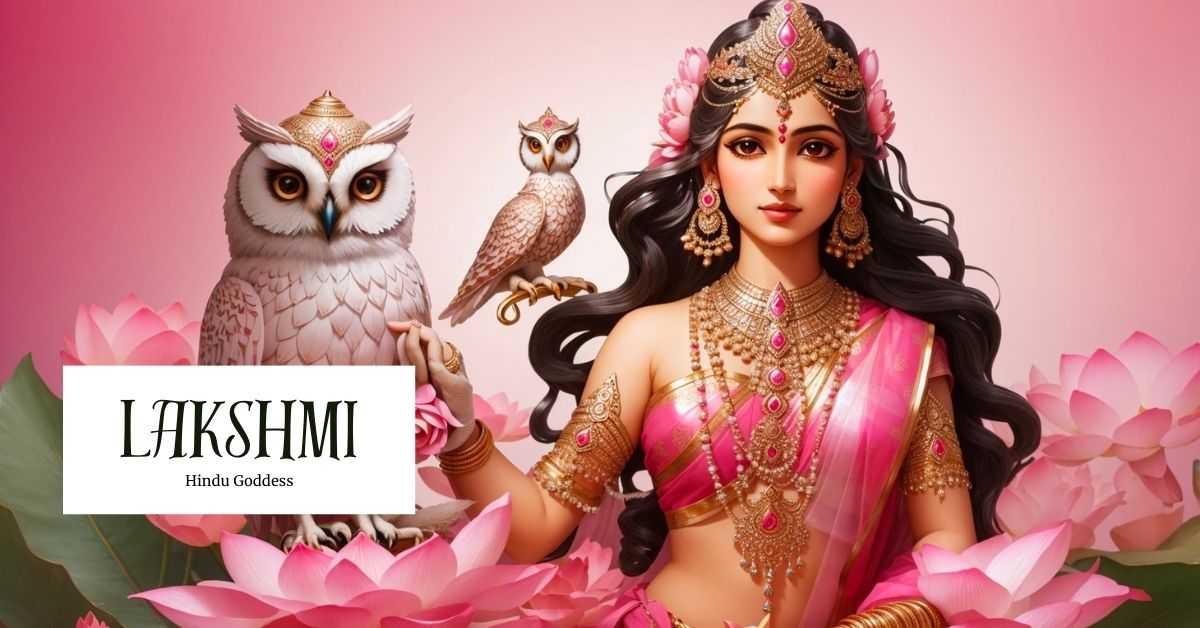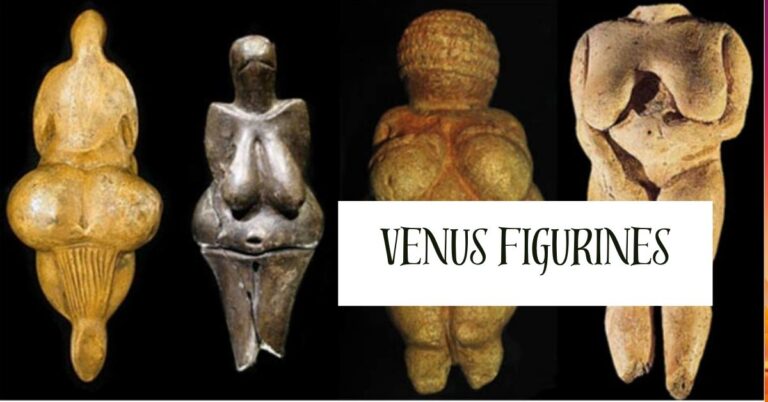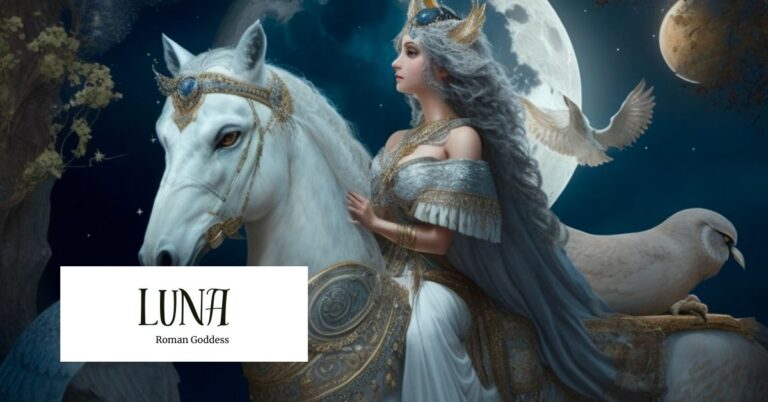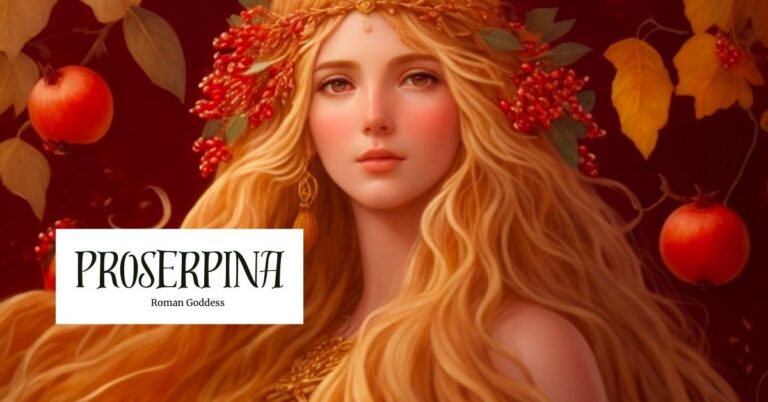Lakshmi: Goddess Of Wealth And Prosperity
Lakshmi, the goddess of wealth, prosperity, and fortune, is a revered figure in Hindu mythology with immense significance to millions of devotees worldwide. In Hindu cosmology, she embodies beauty, grace, and abundance, possessing multifaceted aspects that make her a fascinating subject of study.
Overview of Lakshmi
Derived from the Sanskrit roots lakṣ (लक्ष्) and lakṣa (लक्ष), meaning ‘to perceive, observe, know, understand’ and ‘goal, aim, objective’ respectively, the name Lakshmi embodies the symbolism of knowing and understanding one’s goals (Wikipedia Contributors). Also known as Sri or Mahalakshmi, Lakshmi is a central figure in Hinduism, as the consort of Lord Vishnu and the preserver of the universe. As such, she incarnates in various forms to fulfill different divine purposes, making her a complex figure worthy of deeper exploration. As a source of spiritual prosperity and well-being, she is seen as the guardian of righteous values and a source of divine grace, making her a crucial deity in Hindu mythology.
Source: Etsy
Titles
- Auspicious One
- Consort of Vishnu
- Goddess of Beauty
- Lotus Goddess
Abilities
Lakshmi is the patroness of seven types of wealth. These include monetary wealth (dhana), agricultural wealth, victory, elephants (a traditional Hindu symbol of wealth), wealth of courage, knowledge, and progeny. The last type of wealth signifies Lakshmi’s continued association with fertility in modern times, similar to the Vedic goddess Shri. Cosmologically, Lakshmi’s fertility takes the form of Vishnu’s Maya, which is the magical power that enables him to generate the material aspect of the universe (“Lakshmi – New World Encyclopedia”).
Characteristics
In illustrations, Lakshmi is a radiant goddess adorned with exquisite garments and precious jewels. She has a consistently calm and loving expression. Typically, she is seated or standing on a lotus, which symbolizes purity and beauty. Lakshmi is often depicted in art as standing or sitting on a lotus flower, holding a water pot, and a single lotus flower in her hands, always either blue or pink. With her other two hands, she usually offers a sign of blessing and showers coins on her loyal devotees. The goddess usually wears a pink sari and is accompanied by various traditional symbols of good luck, such as painted elephants adorned with garlands of flowers, often spraying water from their trunks. Lakshmi is frequently depicted next to her husband Vishnu in temple decorative sculpture, for example, massaging his feet with lotus flowers or riding his gigantic man-bird vehicle Garuda (Cartwright).
Source: Freepik
Traits
Lakshmi is renowned for her physical beauty and divine qualities. One of the most prominent attributes associated with her is compassion. She is known to embody kindness and offer solace to her devotees, providing them with emotional and spiritual support during difficult times. Her kindness and selflessness are her most divine traits, and her devotees seek her presence to alleviate their suffering. She inspires her devotees to embrace a giving nature and engage in acts of charity and philanthropy. Her selflessness is considered a model for her followers to emulate, and people revere her for her ability to inspire people to become more compassionate and generous.
Symbols
As the Lotus Goddess, one of Lakshmi’s symbols is the lotus flower, representing purity, enlightenment, and spiritual growth. The lotus flower has many meanings in Hinduism and represents the divine presence of the gods and goddesses. Lakshmi’s connection to the lotus flower represents her purity and divine nature (Cartwright). The owl is considered another symbol of Lakshmi and represents wisdom and the ability to see beyond the surface of things (The Editors of Encyclopaedia Britannica).
Source: Stock
Festivals and Rituals
Lakshmi, the revered Hindu goddess of wealth, prosperity, and fortune, is an important deity in Hinduism. Devotees of Lakshmi celebrate various festivals and perform rituals to express their devotion and seek her blessings. One of the most significant festivals dedicated to Lakshmi is Diwali, also known as the Festival of Lights. During Diwali, devotees illuminate their homes and create intricate rangoli designs to welcome the goddess and invite her blessings for wealth and prosperity.
The festival is celebrated across India with great enthusiasm and devotion, and it is believed that by worshiping the goddess during this time, one can attain financial success and good fortune. Many Hindus, particularly businessmen, can be seen worshiping their account books during Diwali, seeking the blessings of the goddess for financial success. Meanwhile, farmers may offer sacrifices of goats and sheep in hopes of a bountiful harvest. They also sometimes pay visits to dunghills collected for fertilizing future crops, where they genuflect before it in the hopes of ensuring abundant crops in the future (“Lakshmi – New World Encyclopedia”).
Throughout Diwali, clay images of the goddess along with those of Ganesha are worshiped throughout Northern India, in hopes of inheriting some of the good luck meted out by each deity. Lakshmi is a revered goddess in Hinduism, and her presence in festivals and rituals is a testament to her importance in the lives of her devotees.
Source: Behance
Legends associated with Lakshmi
There are several legends associated with Lakshmi that celebrate her divine presence and significance. These legends shed light on the origin of Lakshmi, her role in the cosmic order, and the influence she wields over human life.
Origin story
The Hindu goddess Lakshmi has a varied origin story that differs across various Hindu texts and traditions. One version, as found in the Padma Purana, states that Lakshmi was born from the stirring of the primeval milky ocean by both the gods and demons. It was only after the intervention of Brahma and Vishnu that the goddess miraculously appeared from this ‘sea of clarified butter’ adorned in white, radiating youth and beauty. Because of the nature of her birth one of her many names is Ksirabdhitanaya, which means ‘daughter of the sea of milk’ (Cartwright).
Source: Deviantart
Marrying Lord Vishnu
After the miraculous appearance of the beautiful Goddess Lakshmi from the sea, Devas, Asuras, and Gods all hoped that she would choose one of them as her partner. Amidst the sea of hopeful suitors, Lord Vishnu stood out with his captivating sparkling eyes and mischievous grin. As soon as their eyes met, it was clear that there was an undeniable connection. With a smile, Lakshmi chose Vishnu above all others. The Gods were pleased with their union and believed that Lakshmi was the Supreme Goddess who appeared as Lakshmi to become Vishnu’s significant other, his strength, and his support.
The wedding of Lord Vishnu and Goddess Lakshmi was a grand affair that took place during the stirring of the sea. Vishnu, also known as Shreenatha (dearest of fortune), placed Shreevasta, the symbol of Lakshmi, on his chest to symbolize their union. From then on, Vishnu fulfilled his duties as the protector, fighting against the powers of evil, while Lakshmi remained a devoted spouse, showering him with her love and affection.
Their marriage was a union of two powerful entities, each complementing and supporting the other in their respective roles. Lord Vishnu’s strength and prowess complemented Lakshmi’s compassion and nurturing nature, making them a perfect match. Their love story has been celebrated and revered for generations, as a testament to the power of love and devotion (“Marriage Story of Lord Vishnu and Goddess Lakshmi”).
Source: Indiaherald
Getting Married Again
In another myth, Lakshmi got a little tired of her husband and decided to go live with the royal family of King Akasha Raja in southern India. There, she took the name Padmavati. Her husband Vishnu, in the guise of Shrinivas, searched for her and eventually found her. Brahma and Shiva had conspired for the two to meet, and they fell in love. They married again in a lavish ceremony, which is still commemorated today in Tirupati in southern India (Cartwright).
Source: English.
Influences of other religions/cultures on Lakshmi
The veneration of Lakshmi, the Hindu goddess of wealth and prosperity, has extended beyond the boundaries of Hinduism and has influenced other religions and cultures throughout history. For instance, in Buddhism, the figure of Vasudhara, often depicted with characteristics similar to Lakshmi, is revered as the goddess of wealth and abundance. The concept of Vasudhara is believed to have been inspired by the popularity of Lakshmi’s worship in ancient India. Similarly, in Jainism, the goddess Padmavati bears striking similarities to Lakshmi. She is worshiped as the deity of wealth and fertility, and her depiction in Jain art mirrors that of Lakshmi in Hindu art.
These cross-cultural influences demonstrate the universal human desire for prosperity and abundance, which has transcended religious boundaries and taken on different forms in various traditions. The enduring appeal of Lakshmi’s worship is evident in the numerous temples and shrines dedicated to her across the Indian subcontinent and in Hindu communities worldwide.
Modern appearances
Furthermore, Lakshmi’s image is frequently depicted in Hindu art, spanning from ancient sculptures to contemporary paintings. These artistic depictions showcase her beauty, grace, and association with wealth and abundance. Her portrayal in Hindu mythology also highlights her role as a loving and nurturing mother figure, who ensures the well-being of her devotees. She’s viewed as graceful and loving, rather than other depictions of goddesses that highlight a destructive nature. These various forms of veneration and artistic depictions ensure that Lakshmi remains an integral part of Hindu rituals, festivals, and daily life, embodying the values of prosperity, abundance, and well-being.
Source: Fineartamerica
Final thoughts
Lakshmi, the Hindu goddess of wealth and prosperity, has long been revered by devotees seeking material and spiritual well-being. Her origin is shrouded in myth and legend, with tales of her divine interventions inspiring awe and reverence among her many followers. Though her worship is deeply rooted in Hinduism, Lakshmi’s influence can be seen across many cultures and religions, highlighting the universality of her significance.
Despite the passage of time, Lakshmi’s worship remains a vibrant and integral part of the lives of millions of people worldwide on this earth. Her presence is seen as a source of hope and inspiration, as her legends and enduring traditions symbolize the pursuit of a harmonious and prosperous life, both inwardly and outwardly. Whether through offerings of flowers and incense or meditative practices, devotees continue to seek Lakshmi’s blessings and guidance in their daily lives.
References
Cartwright, Mark. “Lakshmi.” World History Encyclopedia, 14 Aug. 2015, www.worldhistory.org/Lakshmi/.
“Lakshmi – New World Encyclopedia.” Www.newworldencyclopedia.org, www.newworldencyclopedia.org/entry/lakshmi.
“Marriage Story of Lord Vishnu and Goddess Lakshmi.” Www.exoticindiaart.com, www.exoticindiaart.com/blog/marriage-story-of-lord-vishnu-and-goddess-lakshmi/#:~:text=The%20Sacred%20Union%20of%20the%20Supreme%20Power&text=The%20Gods%20approved%20of%20the. Accessed 16 July 2023.
The Editors of Encyclopaedia Britannica. “Lakshmi | Hindu Deity | Britannica.” Encyclopædia Britannica, 2019, www.britannica.com/topic/Lakshmi.
Wikipedia Contributors. “Lakshmi.” Wikipedia, Wikimedia Foundation, 18 July 2019, en.wikipedia.org/wiki/Lakshmi.







